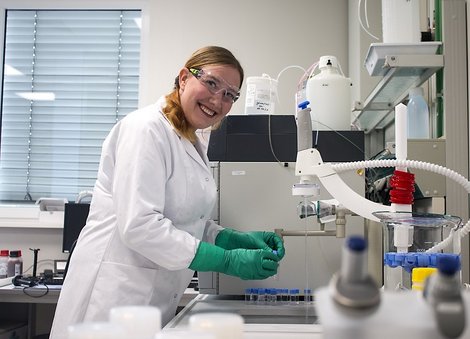Solvay continues its success story with the production of ultra-high-purity hydrogen peroxide
One of the most modern production facilities in Europe can be found in Saxony-Anhalt

H2O2, or hydrogen peroxide, is an essential part of our everyday lives. There is significant demand for the liquid compound of hydrogen and oxygen, which can be used as a cleaning agent, odor absorber, bleach or disinfectant. As long ago as the 1990s, the global Solvay Group built plants for manufacturing and purifying hydrogen peroxide at its historic sodium carbonate production site in the town of Bernburg in Saxony-Anhalt. Since then, demand for the chemical from the semiconductor industry has increased significantly and Solvay has responded by constructing a new state-of-the-art production facility for high-purity hydrogen peroxide.
For more than 130 years, sodium carbonate has been produced on the industrial site in Köthensche Straße in Bernburg near the River Saale. In 1880, the Belgian inventor and industrialist Ernest Solvay applied for approval to build a sodium carbonate factory in Bernburg. The plant opened three years later and has been a key part of the economy in the region ever since. During the GDR years, it was “temporarily” a publicly owned enterprise. In 1991, the factory was returned to the Solvay Group, which has its global headquarters in Brussels and its German headquarters in Hanover. Since then, Solvay has expanded its portfolio of products to include other basic chemicals, some of which are manufactured in Saxony-Anhalt.
The world’s purest hydrogen peroxide
The security guard at the plant shows visitors on a map of the site the route they need to take to reach the sodium carbonate, sodium bicarbonate and hydrogen peroxide production facilities. The Solvay Group’s leading position on the world market is based on these three products. The ammonia-based Solvay Soda process developed by Ernest Solvay is still in use today, primarily in the glass industry. Sodium bicarbonate plays a role in protecting the environment, in particular as part of a flue gas treatment process developed by Solvay. And hydrogen peroxide is a business area with significant potential for growth.
The sign pointing to a building where a new chapter of Solvay’s history in Bernburg is being written says “Electronic Grade.” It refers to the production of electronic grade hydrogen peroxide. Plácido Garcia is head of the electronic wet chemicals business unit. “Electronic wet chemicals are a major growth market,” says Garcia, a chemist from Spain who completed his doctorate in Wuppertal. Referring to the trend for digitalization, he explains: “The increasing miniaturization of the circuits means that the chips are smaller and more complex. The chip manufacturers need high-purity H2O2 to repeatedly clean the silicon wafers that are built up in layers to form the chips.”
Seven years ago, Garcia, who is now 48, came to the Solvay plant to continue the company’s success story in Bernburg, with the production of ultra-high-purity hydrogen peroxide as a key chemical for the semiconductor industry. Some of the purest forms of hydrogen peroxide in the world are now manufactured in Bernburg and sold to the global players on the semiconductor market in Europe.
Highly automated production facility
“We develop the technologies here that Solvay uses in its own H2O2 purification plants at its sites in Asia, the USA and Europe,” says Thomas Plötzke. He joined the plant in Bernburg in the mid 1980s as a mechatronics engineer. A few years later, he completed a course to become an industrial specialist in chemical technology. Now the 50-year-old Plötzke is responsible for one of the most modern production plants for high-purity hydrogen peroxide in Europe. It came into operation in March 2021 and fulfils the high standards of quality required by the European semiconductor industry. Thomas Plötzke highlights the state-of-the-art technology: “Our expertise, which we have developed on the basis of many years of technical and practical experience, is what enables us to meet our customers’ needs.”
Focus on sales markets in Europe
The highly automated plant sends samples itself to the laboratory for quality control purposes. The lab is managed by Josephine Rost. When she talks about impurities, she measures them in ppt or parts per trillion. That is the equivalent of ten grains of salt in an Olympic swimming pool – a truly electronic quality. “We can provide our customers with the highest standard of quality on a consistent basis. They can rely on our quality controls from manufacturing and filling through to delivery in ISO containers,” explains Josephine Rost. Her dream of getting a challenging job in the region where she was raised has been fulfilled. The Solvay plant helps to encourage the young talents in the region and benefits when students from Martin Luther University Halle-Wittenberg, Otto von Guericke University Magdeburg and Anhalt University of Applied Sciences in Köthen write their dissertations at the facility. The 15-person electronic wet chemicals team consists of lab technicians, chemists and mechatronic engineers. Josephine Rost began working in the lab eight years ago directly after completing her chemistry degree. Now, aged 35, she has a management role.
“The boost to digitalization given by the coronavirus pandemic, among other things, is leading to significant growth in the chip business. We will continue to invest so that we can respond flexibly to changes in the market and, at the same time, ensure that our customers are always satisfied,” says Plácido Garcia. He is also thinking of Silicon Saxony, which is located in the Dresden-Freiberg-Chemnitz region. One of Europe’s largest microelectronics and IT clusters is growing up almost on the doorstep.
Author: Kathrain Graubaum/IMG Saxony-Anhalt
